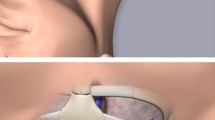Abstract
Purpose
Real-time ultrasound-assisted guidance for catheterization of the internal jugular vein (IJV) is known to be useful, especially for a small-sized vein, which is difficult to catheterize. However, one of the problems with real-time ultrasound-assisted guidance is that the ultrasound probe itself can collapse the vein. We have developed a novel “skintraction method (STM)”, in which the puncture point of the skin over the IJV is stretched upwards with several pieces of surgical tape in the cephalad and caudal directions with the aim being to facilitate catheterization of the IJV. We examined whether this method increased the compressive force required to collapse the IJV.
Methods
In ten volunteers, the compressive force required to collapse the right IJV, and the cross-sectional area and anteroposterior and transverse diameters of the IJV were measured with ultrasound imaging in the supine position (SP) with or without the STM or in the Trendelenburg position of 10° head-down (TP) without the STM.
Results
The compressive force to required to collapse the vein was increased significantly with the STM, while the crosssectional area and anteroposterior diameter of the vein in the SP with STM were similar to those in the TP without the STM.
Conclusion
With the STM, not only the cross-sectional area but also the compressive force required to collapse the IJV increased. Thus, the STM may facilitate real-time ultrasoundassisted guidance for catheterization of the IJV by maintaining the cross-sectional area of the vein during the guidance.
Similar content being viewed by others
References
Hosokawa K, Shime N, Kato Y, Hashimoto S. A Randomized trial of ultrasound image-based skin surface marking versus realtime ultrasound-guided internal jugular vein catheterization in infants. Anesthesiology. 2007;107:720–724.
Milling TJ Jr, Rose J, Briggs WM, Birkhahn R, Gaeta TJ, Bove JJ, Melniker LA. Randomized, controlled clinical trial of point-of-care limited ultrasonography assistance of central venous cannulation: the Third Sonography Outcomes Assessment Program (SOAP-3) Trial. Crit Care Med. 2005;33:1764–1769.
Ganesh A, Jobes DR. Ultrasound-guided catheterization of the internal jugular vein. Anesthesiology. 2008;108:1155–1157.
Morita M, Sasano H, Azami T, Sasano N, Katsuya H. The skintraction method increases the cross-sectional area of the internal jugular vein by increasing its anteroposterior diameter. J Anesth. 2007;21:467–471.
Image J. Image processing and analysis in Java. http://rsb.info.nih. gov/ij/
Gordon AC, Saliken JC, Johns D, Owen R, Gray RR. US-guided puncture of the internal jugular vein: complications and anatomic considerations. J Vasc Interv Radiol. 1998;9:333–338.
Alderson, PJ, Burrows FA, Stemp LI, Holtby HM. Use of ultrasound to evaluate internal jugular vein anatomy and to facilitate central venous cannulation in paediatric patients. Br J Anaesth. 1993;70:145–148.
Hayashi Y, Uchida O, Takaki O, Ohnishi Y, Nakajima T, Kataoka H, Kuro M. Internal jugular vein catheterization in infants undergoing cardiovascular surgery: an analysis of the factors influencing successful catheterization. Anesth Analg. 1992;74:688–693.
Ultrasound guidance of central vein catheterization. Making health care safer: a critical analysis of patient safety practices. In: Rothschild JM, editor. Evidence report/technology assessment, no. 43. Rockville, MD: Agency for Healthcare Research and Quality, publication no. 01-E058. 2001. p. 245–253.
Guidance on the use of ultrasound locating devices for placing central venous catheters. National Institute for Clinical Excellence. Technology appraisal no. 49. Issue date: September 2002. http://www.nice.org.uk/nicemedia/pdf/Ultrasound_49_ GUIDANCE.pdf (accessed July 2008).
Mallory DL, Shawker T, Evans RG, McGee WT, Brenner M, Parker M, Morrison G, Mohler P, Veremakis C, Parrillo JE. Effects of clinical maneuvers on sonographically determined internal jugular vein size during venous cannulation. Crit Care Med. 1990;18:1269–1273.
Armstrong PJ, Sutherland R, Scott DH. The effect of position and different manoeuvres on internal jugular vein diameter size. Acta Anaesthesiol Scand. 1994;38:229–231.
Parry G. Trendelenburg position, head elevation and a midline position optimize right internal jugular vein diameter. Can J Anaesth. 2004;51:379–381.
Author information
Authors and Affiliations
About this article
Cite this article
Sasano, H., Morita, M., Azami, T. et al. Skin-traction method prevents the collapse of the internal jugular vein caused by an ultrasound probe in real-time ultrasound-assisted guidance. J Anesth 23, 41–45 (2009). https://doi.org/10.1007/s00540-008-0703-6
Received:
Accepted:
Published:
Issue Date:
DOI: https://doi.org/10.1007/s00540-008-0703-6




